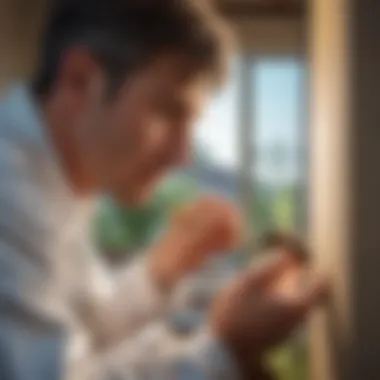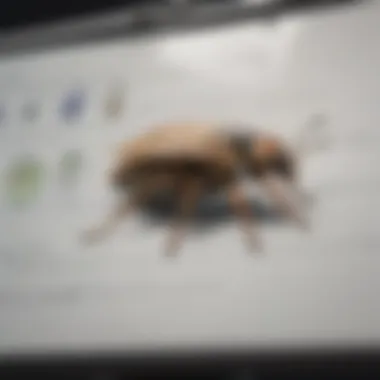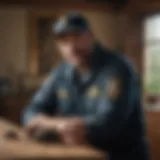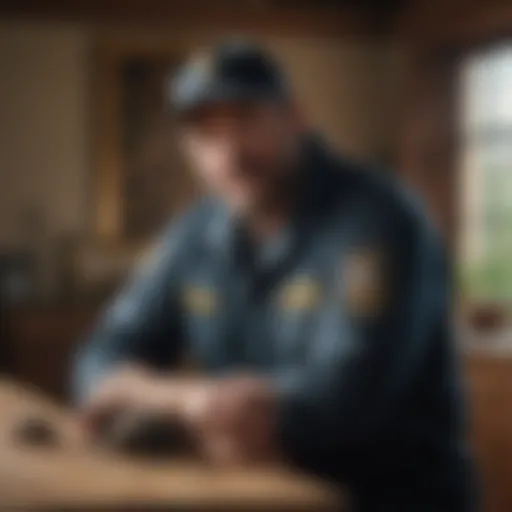Rise of Pest Control Strategies in Omaha


Preventive Pest Control Strategies
Effective pest control begins with proactive measures to prevent infestations before they occur. Understanding and implementing preventive pest control strategies help maintain a pest-free home environment in Omaha. This section delves into various methods tailored for both residential and commercial settings.
House Exterior Protection
The exterior of your home is often the first line of defense against pests. By strengthening this barrier, you reduce the risk of pests entering your living space. Here are some essential tips:
- Tips for sealing cracks: Identifying cracks along windows, doors, and the foundation is crucial. Use caulk or weatherstripping to seal these openings, as they can serve as gateways for pests like ants and spiders.
- Clearing debris: Regularly clear debris such as leaves, wood, or stored items from around your home. This creates a less inviting environment for pests, which thrive in cluttered spaces.
- Preventing pests from entering: Ensure that doors and windows close tightly. Installing screens can also provide an additional barrier against flying insects, particularly during warmer months.
Yard Maintenance
Yard maintenance plays a vital role in pest control. A well-maintained garden not only enhances your property’s aesthetic but also minimizes pest activity. Consider the following yard care routines:
- Essential yard care routines: Regular mowing, watering, and pruning can significantly impact pest populations. Keep grass short and avoid over-watering, as standing water attracts mosquitoes and other pests.
- Methods for keeping yard pest-free: Introducing beneficial insects, like ladybugs and lacewings, can help control aphid populations. Furthermore, rotating plants and using companion planting can deter unwanted pests naturally.
Indoor Cleanliness
Maintaining a clean indoor environment is essential in preventing pest infestations. Here are expert cleaning strategies to keep in mind:
- Expert cleaning tips and techniques: Regularly vacuum floors and upholstery to remove food particles. Pay special attention to areas behind appliances, where crumbs may accumulate.
- Maintaining a pest-resistant indoor environment: Store food in airtight containers and promptly dispose of trash. Regularly deep-clean your kitchen and dining areas to eliminate potential food sources for pests.
Garbage Disposal
Proper garbage disposal is critical in managing pest issues. Efficient methods include:
- Efficient waste disposal methods: Use garbage bags and bins with tight-fitting lids. Dispose of waste frequently to minimize odors that can attract pests.
- Importance of proper garbage disposal: Not only does proper disposal reduce pest attraction, but it also maintains a hygienic environment, preventing health risks associated with pest infestations.
Other Pest Prevention Strategies
There are additional innovative ways to safeguard your home against pests. Consider implementing the following measures:
- Keep firewood stored away from the home, as it can harbor insects and rodents.
- Utilize physical barriers like mesh screens on vent openings to prevent critters from entering your home.
- Regularly inspect and maintain plumbing to prevent leaks, which attract pests seeking moisture.
Important Note: Prevention is far more effective than treatment. Investing time in preventive measures today can lead to long-term pest management success.
Identifying Pest Risk Areas
Identifying vulnerable areas within your property is a crucial step in effective pest control. This section focuses on common risk zones that should be inspected frequently.
Moisture Prone Areas Inspection
Moisture provides an ideal habitat for many pests.
- Identifying damp conditions: Look for leaks under sinks, in basements, and around windows.
- Tips for preventing infestations: Ensure proper drainage around the foundation and use dehumidifiers in damp areas.
Crack and Crevice Inspection Guide
Inspecting for potential access points is critical.
- Importance of inspecting access points: Regularly examine cracks in walls and foundations.
- Strategies for sealing cracks and crevices: Use expanding foam or caulking for effective sealing.
Greenery Inspection for Pest Risks
Your yard can influence pest presence in your home.
- Understanding greenery's impact on pests: Overgrown plants can harbor pests.
- Guidelines to maintain pest-free yards: Regularly trim shrubs and remove any dead plants.
Additional Pest Risk Areas
Other areas to inspect include:
- Attics: Look for signs of rodents or insects.
- Garages: Clutter can attract various pests.
- Birdhouses: Ensure they are properly maintained and don’t attract unwanted species.
Effective Pest Control Methods
Once you identify the problem areas, effective pest control methods come into play. This section evaluates various solutions available for homeowners in Omaha.
Natural Repellents for Pest Control
Natural solutions can be both safe and effective.
- Safe and effective natural solutions: Consider using vinegar or baking soda as natural deterrents.
- Use of essential oils, herbs, and plants: Oils like peppermint or tea tree oil act as natural repellents against common pests.
Chemical Sprays for Pest Control
While natural methods are effective, chemical solutions also have their place.
- Safe usage of professional sprays: Always follow instructions to ensure safety.
- Eradicating pests with chemical solutions: This method is particularly useful for severe infestations.
Pest Traps: Effective Pest Control Solutions
Traps can be crucial in managing pest issues.


- Setting up and using pest traps: Position traps strategically near entrances.
- Capturing and removing pests safely: Follow the manufacturer's guidelines for humane traps.
Biological Control Methods for Pest Prevention
Utilizing nature can be effective.
- Using natural predators for pest management: For instance, ladybugs can control aphid populations.
- Environmental-friendly pest control techniques: These methods limit chemical usage and promote ecological balance.
Other Pest Control Methods
Innovation is driving pest control methods.
- Consider integrated pest management approaches that combine several strategies for higher effectiveness.
- Regular training for house owners and staff on pest management can lead to better outcomes.
The End
In concluding, proactive pest control strategies are essential. From exterior protection to effective control methods, the information provided offers a thorough understanding suitable for housewives and house owners. Implementing these strategies will lead to a more pleasant living environment while minimizing the risks associated with pests.
Intro to Pest Control in Omaha
Pest control is a crucial topic for homeowners and residents in Omaha. The presence of unwanted pests can lead to several challenges, including health risks and property damage. Understanding pest control and its relevance in Omaha assists homeowners to address these challenges effectively. The increasing urbanization and climate changes are making pest management more pertinent than ever. With various local pest species, knowing the pest control options available is vital for maintaining a safe and healthy living environment.
Overview of the Pest Control Industry
The pest control industry is diverse and primarily focused on managing pest populations that pose threats to human health and property. It includes various services aimed at the extermination and prevention of pests, such as insects and rodents. In Omaha, the industry is growing due to increased awareness and demand for effective solutions. Companies like Terminix, Orkin, and local providers have expanded their services to meet this need. Strategies may include regular inspections, treatments, and preventive measures to keep homes pest-free.
In this industry, service technicians are trained to identify problems and implement solutions that suit local conditions. With advanced pest management techniques, these experts work to ensure optimal outcomes for residential and commercial clients. The overall goal remains consistent: to protect homes, families, and businesses from potential infestations and the implications that follow.
Historical Context of Pest Control Services in Omaha
The history of pest control in Omaha reflects wider agricultural practices and urban development. Early pest control methods were often rudimentary and involved basic extermination techniques. Farmers initially sought to protect their crops from pests, using means that included traps and natural repellents. As Omaha grew, so did the complexity of pest control needs.
In the late 20th century, health concerns related to pests began to shape the industry. Significant public awareness regarding diseases caused by pests, such as rodents or ticks, led to the adoption of more sophisticated pest control measures. Local regulations began to emerge that guided pest control practices in Omaha, ensuring that methods employed were safe for both the environment and public health.
Today, residents have a variety of options at their disposal. They can choose between commercial pest control services or DIY methods, depending on their specific situations. The historical context illustrates the evolution of pest management from simple practices to advanced techniques tailored to meet modern demands.
Factors Contributing to the Rise in Pest Control Demand
As cities expand and lifestyles change, the demand for pest control services increases notably. The urgency for pest management stems from several factors. Understanding these factors helps in comprehending the pest control landscape, particularly in Omaha. This examination looks beyond the immediate needs and digs into the trends reshaping pest control usage.
Urbanization and Its Effects
Urbanization continues to influence various aspects of daily life. As more people move to urban areas, the population density rises. This environment becomes conducive for pests as they find abundant food sources and places to breed. Omaha is no exception. The migration to urban settings increases interactions between humans and wildlife, leading to pest problems. Common issues include rodent infestations and insect swarms, which tend to thrive in higher populations.
Furthermore, construction activities in developing neighborhoods often disrupt natural habitats, pushing pests into residential and commercial properties. Residents find themselves in need of pest control services as they confront these intrusions. \nIn this context, pest control becomes not just a convenience but a necessity for maintaining health and safety in living spaces.
Climate Changes and Pest Dynamics
Climate change introduces complexities to pest behaviors and distributions. Shifts in temperature and weather patterns have been linked to altered pest populations and increased incidences of infestations. In Omaha, warmer summers and milder winters can enable pests to survive longer and reproduce continuously, contributing to higher pest populations.
In particular, insects such as mosquitoes and termites react significantly to climatic changes, often leading to more frequent and severe infestations. These shifts necessitate more persistent pest control efforts. Residents may feel overwhelmed and uncertain about how to maintain a pest-free environment, driving demand for professional services.
Increased Public Awareness of Health Risks
Public awareness regarding health risks associated with pests has risen considerably in recent years. Information from health organizations highlights the dangers of pest-borne diseases, such as West Nile virus from mosquitoes and Hantavirus from rodents. Moreover, many consumers are now informed about allergens and irritants related to pests, recognizing their potential impact on overall well-being.
The increased knowledge encourages homeowners and businesses alike to prioritize pest control. Not only is it essential for comfort, but it is also vital for safeguarding health. As people become more aware of the consequences of pest infestations, demand for reliable pest control services continues to grow.
In summary, the rise in pest control demand in Omaha is closely tied to urbanization, changing climate patterns, and heightened awareness of health risks. Addressing these elements is critical for ensuring effective pest management strategies and maintaining safe living and working environments.
Common Pests in Omaha
In Omaha, being aware of common pests is essential for effective pest management. Understanding which pests are prevalent in the area enables homeowners and businesses to take appropriate preventive measures. Identifying these pests can also guide decision-making when it comes to selecting pest control services. Besides, knowing the characteristics and behaviors of pests helps in choosing the right management strategies. By addressing common pests efficiently, one can protect health and property effectively.
Identifying Local Pests
Rodents
Rodents are among the most common pests found in Omaha. They include species such as mice and rats, which are notorious for invading homes and commercial properties. One of their key characteristics is their ability to reproduce quickly, leading to large infestations if left unchecked. This rapid breeding is a significant concern in pest management, as it escalates the problem swiftly.
From a practical standpoint, rodent infestations can result in various health risks, including the transmission of diseases. Additionally, they can cause property damage, as they often chew on electrical wires and insulation. Recognizing the signs of rodent activity, such as droppings or gnaw marks, is crucial for early intervention. The advantage of understanding rodent behavior is that it facilitates timely pest control actions, ensuring a safer environment.
Insects
Insects, particularly ants and cockroaches, also rank high among the common pests in Omaha. These pests are known for their adaptability, making them a frequent nuisance in both residential and commercial spaces. Their key characteristic is the sheer variety of species that can infest a property, often varying in behavior and requirements. For instance, carpenter ants can damage wooden structures, while cockroaches can contaminate food and surfaces.
The unique feature of insects lies in their ability to enter buildings through even the smallest openings. This poses a challenge for prevention strategies. Understanding their habits can inform better pest control tactics. For example, sealing cracks and utilizing bait can help manage infestations effectively. The importance of insects in pest control discussions cannot be understated, as their presence can significantly affect the health and hygiene of an environment.
Termites
Termites are often overlooked yet possess a profound impact on homes and buildings in Omaha. These pests are recognized for their wood-eating behavior, which can lead to severe structural damage if not addressed promptly. Their key characteristic is their capability to remain hidden, often causing damage before they are detected.
One unique feature of termites is their social structure, which enables them to work cohesively in large colonies. This efficiency makes eradication more challenging, but understanding this behavior can provide insights into targeted treatment methods. The advantages of identifying termite activity early are substantial, as they allow homeowners to preserve their property and avoid significant repair costs. Being vigilant for signs of termite infestation, such as mud tubes or damaged wood, is vital in maintaining a pest-free environment.


Impact of Pests on Health and Property
Pests can have serious implications for both health and property. For homeowners, common pests can lead to health risks due to the diseases they carry. Rodents and insects can contaminate food supplies and living spaces, posing serious threats to health. Minimizing exposure to these pests is vital for maintaining a safe household.
On the property side, damage from pests can also be considerable. Rodents chew through insulation and wires, while termites can compromise the structural integrity of a home. This not only incurs repair costs but also disrupts the peace of daily life.
Educating oneself about common pests is the first step in effective pest management, protecting both health and property from potential threats.
Pest Control Methods and Techniques
Pest control methods and techniques play a critical role in managing pest populations effectively. Understanding these methods is essential for home and property owners. Without the right approach, pest infestations can lead to damage and health risks. Therefore, selecting the appropriate technique can greatly influence outcomes in pest management. Here, we will explore the main pest control solutions available today, as well as consider their benefits and challenges.
Chemical Pest Control Solutions
Chemical pest control solutions involve using insecticides and pesticides to eliminate pests. These products can be effective in quickly reducing pest populations. For homeowners, chemical solutions are often the first line of defense when dealing with an infestation.
There are various types of chemical solutions available:
- Insecticides: Target insects specifically. They are effective against ants, roaches, and other common pests.
- Rodenticides: Designed for controlling rodent populations, these are hazardous to pets and children if not applied correctly.
- Fungicides: Help in managing mold and fungi that can thrive in damp conditions in homes.
While chemical solutions can provide rapid results, it is crucial to consider potential drawbacks. Prolonged exposure to certain chemicals can lead to health concerns for humans and pets. Additionally, improper application can harm beneficial insects and disrupt local ecosystems. Therefore, using these chemicals responsibly and according to manufacturer guidelines is vital.
Physical and Mechanical Control Tools
Physical and mechanical pest control tools include non-chemical methods to manage pests. These tools are practical for both immediate and long-term pest control strategies. Examples include traps, barriers, and exclusion devices.
Some common physical methods are:
- Traps: Used for catching rodents and insects. They can be a humane option, allowing for relocation of captured pests.
- Barriers: Physical barriers can prevent pests from entering homes. Weather stripping, caulking, and mesh screens can be effective measures.
- Vacuuming: A straightforward and effective way to remove insects and their eggs, particularly in the case of spiders or bed bugs.
The benefits of physical control methods are significant. They often minimize the risks associated with chemical exposure and provide immediate results. However, they may require more ongoing effort and maintenance to be effective
Biological Control Strategies
Biological control strategies involve using natural predators or microbial agents to manage pest populations. This method can lead to sustainable pest management practices. Biological control is an increasingly popular choice for environmentally-conscious homeowners.
Some biological control methods include:
- Beneficial Insects: Ladybugs and lacewings can help manage aphid populations naturally without the need for chemicals.
- Entomopathogenic Nematodes: Microscopic worms that target pests like grubs and soil-dwelling insects.
- Natural Pesticides: Extracts from plants, like neem oil, can deter pests while having lower toxicity to humans and pets.
Biological controls present several advantages. They work in harmony with the environment and can help maintain biodiversity. Furthermore, these strategies often lead to long-term pest control success. On the other hand, they might take longer to show effects compared to chemical solutions. A combination of methods can often yield the best result.
Effective pest management relies on understanding the nuances between different methods and the context of each situation.
Integrated Pest Management Systems
Integrated Pest Management (IPM) represents a comprehensive approach to pest control that acknowledges the complexity of pest behavior and the need for sustainable practices. As the demand for effective pest management rises, understanding the IPM framework is essential to both homeowners and pest management professionals in Omaha. This approach merges multiple tactics to prevent and control pest populations, focusing on minimizing risks to human health and the environment.
The implementation of IPM offers numerous benefits. Firstly, it reduces the reliance on chemical pesticides, which can present health risks and environmental concerns. Instead, IPM emphasizes prevention and monitoring, alongside the judicious use of chemicals when necessary. This balanced strategy not only protects the ecosystem but also ensures that pest control methods are effective long-term.
Secondly, IPM is economically advantageous. By focusing on prevention strategies, such as proper sanitation, habitat modification, and exclusion techniques, property owners can minimize infestations. The long-term savings from reducing pest damage and avoiding costly treatments enhance the economic rationale for adopting IPM.
In summary, the concept of Integrated Pest Management stands as a critical component in the realm of pest control, particularly in urban environments like Omaha, where interactions between human supply and pest demands are complex.
Concept and Benefits of IPM
The concept of Integrated Pest Management encompasses a systematic and informed approach to pest control. At its core, IPM integrates several strategies into a single management plan that considers ecological principles, pest life cycles, and available control methods. The benefits of utilizing IPM are manifold:
- Reduced Chemical Use: By minimizing pesticide applications, IPM substantially lowers potential health risks and environmental impacts.
- Effective Pest Control: Combining several control methods results in more reliable and sustainable pest management outcomes.
- Economic Savings: Preventive measures often lead to lower overall costs related to pest infestations, thus providing financial benefits over time.
- Enhanced Public Health: By reducing pesticide exposure, IPM contributes to healthier living environments in residential areas.
Incorporating IPM principles within pest management practices reflects a growing recognition of the need for sustainable solutions in today’s world.
Implementation in Residential and Commercial Spaces
Implementing Integrated Pest Management can take various forms in both residential and commercial settings. For homeowners, the initial step often begins with understanding and identifying potential pest threats. Simple strategies, such as:
- Regular Inspections: Homeowners should routinely check for signs of pest activity.
- Sanitation: Maintaining cleanliness can significantly reduce pest attraction.
- Exclusion: Sealing entry points can prevent pests from infiltrating.
For commercial spaces, such as restaurants or grocery stores, IPM requires a more rigorous approach given the higher stakes involved with public health and product integrity. Businesses often engage in:
- Employee Training: Staff should be knowledgeable about pest identification and management procedures.
- Monitoring Systems: Implementing traps and monitoring tools helps provide data for decision-making.
- Collaboration with Pest Control Experts: Regular consultation with pest management professionals can optimize strategies and ensure compliance with local regulations.
Effective implementation of IPM fosters a healthier environment and promotes a community-wide commitment to sustainable pest management practices.
Environmental Considerations in Pest Control
Understanding environmental considerations in pest control is crucial to comprehending the overall impact pest control practices have on the world around us. This section delves into how sustainable practices are vital in managing pests effectively while protecting our ecosystems. With growing concerns over climate change, biodiversity loss, and chemical exposure, integrating environmental considerations into pest control becomes ever more critical.
Sustainable Practices in Pest Control
Sustainable practices in pest control focus on reducing the ecological footprint of pest management methods. This includes using products that have minimal impact on the environment and promoting natural pest control methods whenever possible. Here are several sustainable tactics to consider:
- Integrated Pest Management (IPM): This approach blends multiple strategies—biological, cultural, mechanical, and chemical—aimed at controlling pests while being sensitive to the environment. IPM prioritizes prevention and uses chemicals only when necessary, ensuring a balanced ecosystem.
- Use of Eco-friendly Products: Many pest control companies now offer solutions that use natural ingredients or are biodegradable. This reduces harmful effects on non-target organisms, including beneficial insects, pets, and human health.
- Habitat Modification: Altering the environment to make it less hospitable to pests often results in more sustainable control. This can be as simple as managing standing water to prevent mosquitoes or ensuring proper drainage around structures to deter termites.


By focusing on these sustainable methods, homeowners can engage in pest control that's effective yet gentle on their environment.
Impact on Local Ecosystems
Pest control does not happen in isolation. Every action taken in this field can ripple through local ecosystems. The goal should be to minimize negative impacts while preserving ecological balance. Several potential impacts include:
- Effects on Non-target Species: Pest control measures, especially chemical ones, can inadvertently harm species that are not intended targets. This includes native pollinators and other beneficial insects essential for ecosystem health.
- Soil and Water Quality: Uncontrolled use of chemicals can lead to runoff into local waterways, polluting them and harming aquatic life. Utilizing proper application methods and timing can mitigate these effects, keeping soil and water safe.
- Biodiversity Considerations: Maintaining biodiversity is crucial. A reduction in pest populations must not lead to the decline of other species. Using environmentally considerate practices helps to prevent ecological imbalances.
In summary, understanding environmental considerations in pest control is necessary for developing strategies that are not only effective but also considerate of our ecosystems. By promoting sustainable practices and being aware of the potential impacts on local ecosystems, individuals can contribute to an overall healthier environment.
Local Regulations and Pest Control Practices
Understanding local regulations is vital for effective pest control in Omaha. The laws governing pest management ensure that practices are safe, environmentally friendly, and effective. They set clear guidelines for pest control companies, helping to maintain community health and safety. A solid grasp of these regulations can help homeowners and business owners make informed decisions about pest management services.
Understanding Nebraska’s Pest Control Laws
In Nebraska, pest control is regulated by specific laws that vary by county. These laws aim to protect both residents and the environment. Each pest control provider must be licensed, ensuring that they have met necessary training and certification. One important law is about the proper use of pesticides. Companies must follow strict guidelines regarding pesticide application, especially near schools and daycare centers. This ensures that children and sensitive populations are not inadvertently exposed to harmful chemicals.
Moreover, the Nebraska Department of Agriculture works actively to monitor pest control practices. They conduct inspections and respond to complaints about unauthorized pesticide use. Homeowners should be aware of the rights they have under these laws. For example, they can request information about the products being used in their homes. This transparency is crucial for safety and trust between pest control companies and clients.
Comparing Local Standards to National Guidelines
When examining pest control regulations, it is essential to compare local standards in Nebraska with national guidelines. The Environmental Protection Agency (EPA) sets federal standards for pesticide use, which are designed to protect human health and the environment. However, states like Nebraska can implement stricter rules if they see fit.
In Omaha, local regulations generally reflect federal guidelines while considering local pest issues. For example, the EPA may allow certain pesticides that are deemed safe at the national level, but Nebraska may restrict their use based on regional pest pressures or environmental concerns. This creates a layered approach to pest management, where local conditions influence the regulations.
Moreover, ongoing training and certification are emphasized both locally and nationally. Pest control companies must continuously update their knowledge on new technologies and methods. As training requirements may differ, it is advised for homeowners to choose professionals who not only meet local standards but also stay aligned with national trends.
"Local and national regulations work together to create a comprehensive framework for pest management. Understanding these can enhance our approach to pest issues."
By knowing the local laws, homeowners gain peace of mind. They can ensure that the pest control services they choose comply with relevant standards, promoting safety and effectiveness in pest management.
Choosing a Pest Control Service in Omaha
Choosing a pest control service in Omaha is a strategic decision that can significantly influence the health and safety of both homes and businesses. Given the region's unique pest pressures, it is vital to select a provider that understands local conditions and regulations. A reliable pest control service not only addresses current infestations but also implements preventive measures to mitigate future occurrences. The decision should not be taken lightly, as the wrong choice can lead to ineffective treatment, causing further damage or recurring issues. Thus, understanding how to evaluate service providers and the associated costs becomes essential.
Evaluating Service Providers
When evaluating pest control service providers, several key factors should be taken into account:
- Experience and Reputation: A company with a long history of service typically demonstrates reliability. Look for reviews and testimonials from previous clients to gauge satisfaction.
- Certifications and Licenses: Verify that the company holds the necessary licenses to operate in Nebraska. This ensures they meet established industry standards.
- Range of Services: Check what services are offered. Some pest control companies specialize in certain pests, while others provide comprehensive solutions.
- Treatment Methods: Understanding the methods used is important. Some companies might prefer chemical treatments, while others may utilize integrated pest management, which can be more environmentally friendly.
- Customer Service: Consider the accessibility and professionalism of their customer service. Good communication can indicate how issues will be handled and how they support clients throughout the process.
Choosing a service provider involves research. Make a list of potential candidates and compare their offerings in a structured manner.
Cost Considerations
Cost is a crucial factor when selecting pest control services in Omaha. It is not just about the price; understanding what influences the cost can aid homeowners and businesses in making informed decisions.
- Initial Assessment: Most pest control services will conduct an initial assessment to identify the issue. Some may offer this for free, while others may charge a fee.
- Type of Treatment: The cost varies depending on the type of treatment. For example, specialized treatments for termites can be more expensive than general pest control for common insects.
- Frequency of Visits: Consider whether you need a one-time treatment or ongoing maintenance. Subscriptions or regular contracts may provide savings in the long run.
- Additional Services: Some companies offer supplementary services, such as trapping or exclusion, which may not be included in the base price but could be important for comprehensive pest management.
- Comparing Quotes: Don’t hesitate to ask for quotes from several providers. This not only gives insight into the typical pricing but also allows for comparison of services included in the package.
"The right decision in pest control can prevent a small problem from escalating into a larger and costlier issue."
Future Trends in Pest Control
The pest control industry continuously adapts to the changing environment and consumer behavior. Understanding future trends in pest control is crucial for both providers and consumers. Awareness of these trends can ensure that clients receive effective and sustainable solutions. Moreover, it allows service providers to enhance their offerings and stay competitive in the market. Key trends include the incorporation of new technologies, shifting consumer expectations, and the growing need for environmentally conscious strategies.
Technology’s Role in Pest Management
Technology plays a significant role in modern pest management strategies. Innovations such as smart sensors, drones, and data analytics have transformed how pest control companies operate. For instance, smart sensors can detect pests early, allowing for timely intervention. This approach not only minimizes damage but also reduces the need for extensive chemical applications.
Additionally, drones can be used for surveying large commercial properties, mapping infestations with high precision. This technology enables pest control experts to develop targeted strategies, improving overall effectiveness. The utilization of data analytics also aids in understanding pest behavior and predicting infestations based on environmental conditions.
The rise of digital platforms has also changed customer interaction. Clients can now book services, track pest treatments, and communicate with service providers easily online. This convenience increases customer satisfaction and streamlines operations for pest control businesses. The integration of these technologies contributes to more effective pest management solutions and positions companies favorably in a competitive market.
Evolving Consumer Expectations
The expectations of consumers regarding pest control services are evolving. Homeowners are increasingly aware of health risks associated with pests and chemical treatments. As a result, there is a greater demand for safer, eco-friendly solutions. Customers are now more interested in integrated pest management systems that prioritize sustainability without compromising effectiveness.
Aside from environmental concerns, consumers are seeking transparency from pest control companies. They want to know what methods are being used and how they impact health and the environment. This desire for information is leading many pest control providers to offer detailed explanations of their processes and the ingredients in their treatments.
Moreover, convenience and efficiency are critical to consumers. Many prefer services that they can easily schedule around their busy lives. Therefore, pest control companies are adapting their services to meet these demands, offering flexible scheduling and rapid response options.
The shift towards eco-conscious pest control is not just a trend; it reflects a fundamental change in consumer values.
In summary, the future of pest control in Omaha will heavily rely on technological advancements and an increased focus on sustainability. Pest control companies that recognize and adapt to these trends will likely thrive. Understanding these dynamics is essential for both service providers and consumers eager to make informed choices.
End
Pest management in Omaha is not just a matter of convenience; it is a critical aspect of maintaining a safe and healthy living environment. The significance of effective pest control is evident from the numerous factors explored throughout the article. Ensuring that pest control strategies are well implemented can lead to multiple benefits for homeowners and residents alike.
Recap of Key Insights
- Demand Factors: Urbanization and climate change have greatly influenced the rise in pest populations, leading to increased demand for pest control services.
- Local Pest Types: Familiarity with local pests, such as rodents and termites, is essential for effective management. The knowledge of their behaviors helps in constructing effective prevention strategies.
- Effective Methods: From chemical solutions to integrated pest management systems, various methods can be employed based on the specific needs of the home.
- Regulatory Environment: Understanding Nebraska’s pest control laws is crucial for ensuring that pest control measures are compliant with legal standards.
- Environmental Practices: The emphasis on sustainable practices underscores the importance of protecting local ecosystems while managing pest populations.
Final Thoughts on Pest Management in Omaha
In summary, pest management serves as a multifaceted endeavor that requires understanding specific local dynamics, regulations, and environmental impacts. Homeowners and housewives must remain informed about both the challenges posed by pests and the approaches available for combating them. Effectively engaging with pest control not only protects properties but also promotes overall public health in Omaha.
Overlooking pest control can lead to significant property damage and health risks; therefore, proactive measures are essential.
Ultimately, embracing informed pest management practices fosters a safer and healthier community, allowing residents to fully enjoy their homes without the constant threat of pest intrusions.



